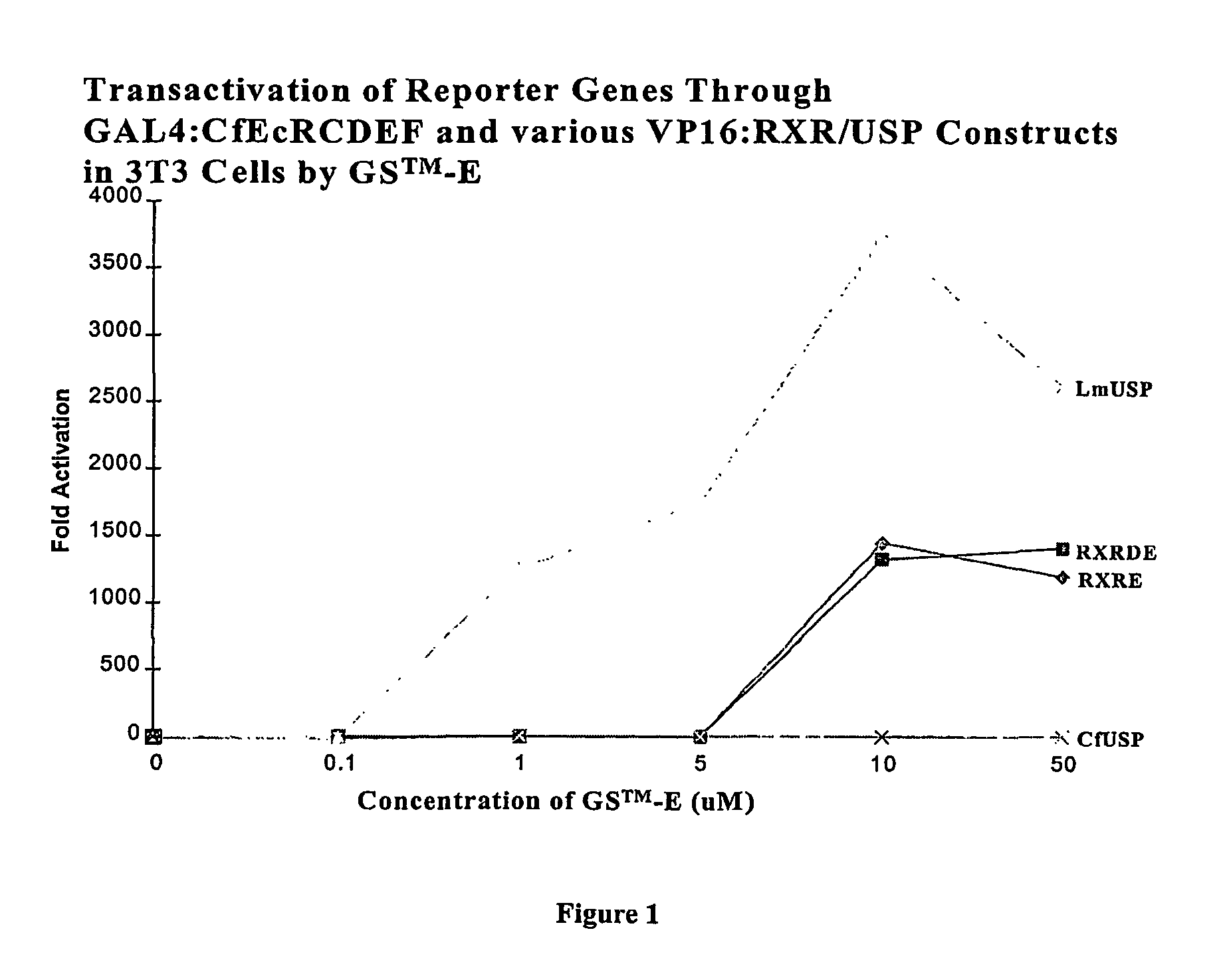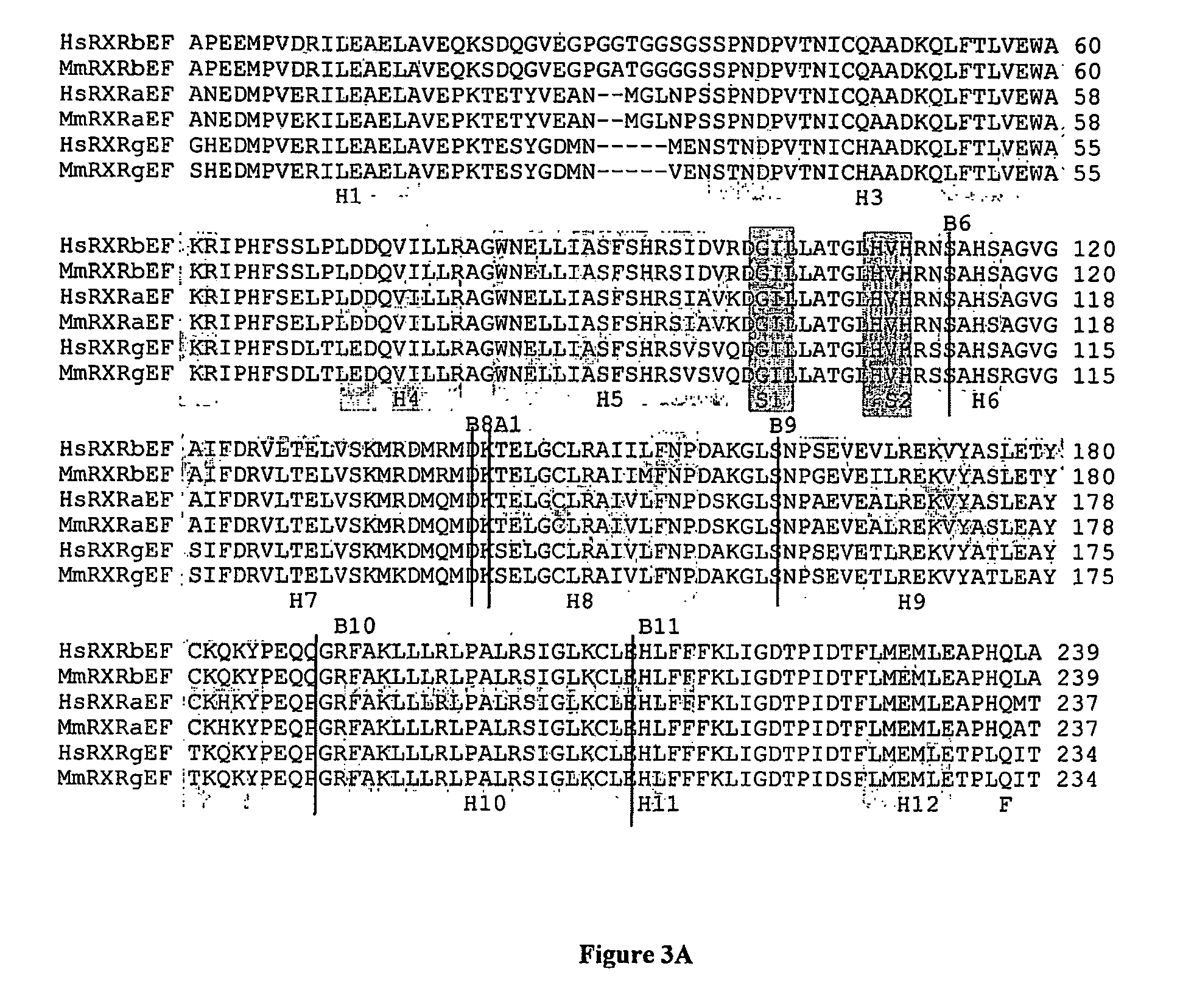Ecdysone receptor/invertebrate retinoid X receptor-based inducible gene expression system
a technology of ecdysone receptor and invertebrate retinoid x receptor, applied in the field of biotechnology or genetic engineering, can solve the problems of system limitation, system leakage, limited use of pr1-a,
- Summary
- Abstract
- Description
- Claims
- Application Information
AI Technical Summary
Benefits of technology
Problems solved by technology
Method used
Image
Examples
example 1
[0246]Applicants' EcR / invertebrate RXR-based inducible gene modulation system is useful in various applications including gene therapy, expression of proteins of interest in host cells, production of transgenic organisms, and cell-based assays. In various cellular backgrounds, including mammalian cells, invertebrate EcR heterodimerizes with vertebrate RXR and, upon binding of ligand, transactivates genes under the control of ecdysone response elements. Applicants have made the surprising discovery that invertebrate RXR can substitute for vertebrate RXR and provide a novel inducible gene expression system for yeast and animal cell applications. This Example describes the construction of several gene expression cassettes for use in the EcR-based inducible gene expression system of the invention.
[0247]Applicants constructed several EcR-based gene expression cassettes based on the spruce budworm Choristoneura fumiferana EcR (“CfEcR”), C. fumiferana ultraspiracle (“CfUSP”), Drosophila me...
example 2
[0249]In a two-hybrid switch format, CfUSP and DmUSP in partnership with CfEcR are constitutively active in both yeast and mammalian cells. On the other hand, vertebrate RXR in partnership with CfEcR is a ligand dependent transactivator in mammalian cells. Applicants tested an invertebrate RXR, LmUSP in a two-hybrid format in mouse NIH3T3 cells to determine if it would function as a USP (constitutively) or as a vertebrate RXR (inducibly) in mammalian cells. Gal4:CfEcR-CDEF (FIG. 1) or Gal4:CfEcR-DEF (FIG. 2) were paired with VP16:MmRXR-DEF; VP16:MmRXR-EF; VP16:LmUSP-DEF; or VP16:CfUSP-EF and analyzed in mammalian cells. Briefly, gene induction potential (magnitude of induction) and ligand specificity and sensitivity were examined using two different ligands: a steroidal ligand (Ponasterone A, “PonA”) and a non-steroidal ligand [N-(2-ethyl-3-methoxybenzoyl)-N′-(3,5-dimethylbenzoyl)-N-tert-butylhydrazine] in a dose-dependent induction of reporter gene expression in the transfected NIH...
example 3
[0252]This Example describes the comparison of vertebrate RXR and invertebrate RXR-based two-hybrid gene expression systems comprising full length or truncated EcR, vertebrate RXR, and invertebrate RXR polypeptides. An amino acid sequence alignment, comparing the EF domains of twelve different vertebrate and invertebrate RXRs is shown in FIGS. 3A and B. As described below, Applicants compared different GAL4 / CfEcR-based switches comprising MmRXRα-EF (a vertebrate RXR), LmUSP-EF (an invertebrate RXR), AmaRXR1-EF (an invertebrate RXR), and AmaRXR2-EF (an invertebrate RXR) fused to a VP16 activation domain to identify the receptors that give a switch with a) maximum induction in the presence of ligand; b) minimum background in the absence of ligand; c) highly sensitive to ligand concentration; and / or d) minimum cross-talk among ligands and receptors in mammalian cells.
[0253]Briefly, full-length EcR and truncated EcRs, created by a truncation mutation at the junctions of A / B, C, D, E and...
PUM
| Property | Measurement | Unit |
|---|---|---|
| Tm | aaaaa | aaaaa |
| Tm | aaaaa | aaaaa |
| Tm | aaaaa | aaaaa |
Abstract
Description
Claims
Application Information
 Login to View More
Login to View More - R&D
- Intellectual Property
- Life Sciences
- Materials
- Tech Scout
- Unparalleled Data Quality
- Higher Quality Content
- 60% Fewer Hallucinations
Browse by: Latest US Patents, China's latest patents, Technical Efficacy Thesaurus, Application Domain, Technology Topic, Popular Technical Reports.
© 2025 PatSnap. All rights reserved.Legal|Privacy policy|Modern Slavery Act Transparency Statement|Sitemap|About US| Contact US: help@patsnap.com



